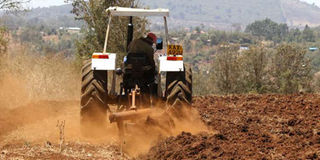Breaking News: KDF chopper crash kills five in West Pokot
Owners of ‘idle’ land should be compelled to produce food

A tractor ploughs at Hill Farm in Nyeri town on September 28, 2015. In a perfect world, the largest land owners would step forward willingly to contribute meaningfully to meeting Sustainable Development Goals by increasing the amount of arable land under cultivation from 8 per cent to 15 per cent. PHOTO | JOSEPH KANYI
What you need to know:
- The vast majority of farmers are holders of small acreages, without the individual wherewithal to acquire more land. For them, the key to the commercial market is improving productivity, diversifying crops, integrating livestock, poultry or beekeeping to the farm ecology system.
- When the current land holding is not large enough to support increased production or larger herds, then specific linkages need to be made among landowners, who may be using a small portion of their land or none and those who are willing to lease a portion or all of it.
It is estimated that only 8 per cent of the total arable land available in Kenya is under cultivation.
It has also been projected that by 2030, two of every five children in the world will live in Africa. If Kenya or any other African country expects to feed its own people and earn export revenue from agriculture, it is clear that much more arable land needs to be intensively farmed.
About 80 per cent of the Kenyan population is engaged in one form or another in the agricultural value chain. It is estimated that 50 per cent of the population is actively engaged in livestock, horticulture and other land-based, income-generating activities whether for subsistence or commercial sale. It is not hard to figure out, then, that to meet current and future demand, far more acreage has to come under cultivation.
Everything starts and ends with productive use of quality land. Here is my four-step suggestion.
a) The vast majority of farmers are holders of small acreages, without the individual wherewithal to acquire more land.
For them, the key to the commercial market is improving productivity, diversifying crops, integrating livestock, poultry or beekeeping to the farm ecology system, using organic fertilisers such as fresh or dried manure, using drip or pump irrigation rather than relying on rain-fed means, using quality, disease-resistant seeds, and healthy livestock breeds. These farmers need to go “deep” rather than “broad”. They need to make their farms more productive and more efficient to lower costs.
b) Livestock and poultry farmers can improve the quality of their herds and flocks and lower costs at the same time by cultivating their own nutritious fodder even in areas where there is minimal rainfall.
Livestock require fodder rich in carbohydrates, minerals, and protein. Local agricultural extension agents can advise on the best mix of plant material to raise nutritional yields, how to intercrop for best results, when to harvest for maximum nutritional value, and when to feed the animals for best digestion. Commercial animal feeds are expensive and some are not of the quality or mixed in the correct ratios for optimum milk production.
c) When the current land holding is not large enough to support increased production or larger herds, then specific linkages need to be made among landowners, who may be using a small portion of their land or none and those who are willing to lease a portion or all of it. There is strength in numbers certainly, so if local farmers organise either into a Sacco or simply community-based groups that can influence the decisions of landowners to rent land or even to allow a “demonstration” farm or a small-scale processing facility to be built on idle land, then a great stride would have been taken in the goal to feed a nation.
d) The last but the most important action to —requesting, cajoling, rewarding, recognising, appealing to and/or even mandating the largest holders of arable land to sell, lease, or donate (for a tax deduction) a percentage of their holdings to single, multiple, or group farm holders, whether commercial groups or community based organisations.
In a perfect world, the largest land owners would step forward willingly in the name of peace, prosperity, and national pride to contribute meaningfully to meeting Sustainable Development Goals to bring people out of poverty, improve nutrition, and reduce food insecurity by increasing the amount of arable land under cultivation from 8 per cent to 15 per cent.




